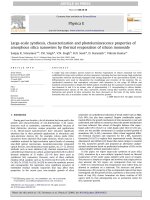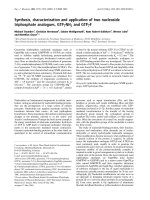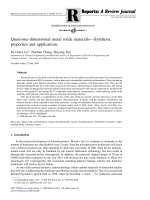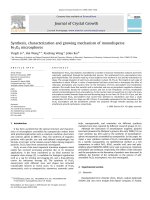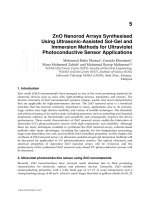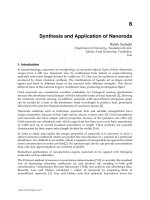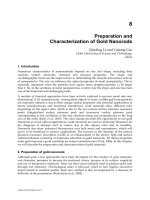flower like tungsten oxide particles synthesis, characterization and dimethyl
Bạn đang xem bản rút gọn của tài liệu. Xem và tải ngay bản đầy đủ của tài liệu tại đây (481.82 KB, 6 trang )
Analytica Chimica Acta 675 (2010) 36–41
Contents lists available at ScienceDirect
Analytica Chimica Acta
journal homepage: www.elsevier.com/locate/aca
Flower-like tungsten oxide particles: Synthesis, characterization and dimethyl
methylphosphonate sensing properties
Yingqiang Zhao
a,b
, Hongmin Chen
a
, Xiaoying Wang
c
, Junhui He
a,∗
, Yunbo Yu
c
, Hong He
c
a
Functional Nanomaterials Laboratory and Key Laboratory of Photochemical Conversion and Optoelectronic Materials, Technical Institute of Physics and Chemistry,
Chinese Academy of Sciences, Zhongguancun Beiyitiao 2, Haidianqu, Beijing 100190, China
b
Graduate University of Chinese Academy of Sciences, Beijing 100049, China
c
Research Center for Eco-Environmental Sciences, Chinese Academy of Sciences, Beijing 100085, China
article info
Article history:
Received 11 May 2010
Received in revised form 23 June 2010
Accepted 24 June 2010
Available online 1 July 2010
Keywords:
Flower-like
Tungsten oxide
Quartz crystal microbalance
Gas sensor
Dimethyl methylphosphonate
abstract
Flower-like WO
3
particles with high specific surface area were synthesized via a template/surfactant-
free way. Scanning and transmission microscopies and X-ray diffraction were applied to investigate
the formation mechanism of the morphology. Gas sensing characterization showed an enhanced sen-
sitivity (70 Hz/ppm) to dimethyl methylphosphonate (DMMP) as compared with previously reported
WO
3
nanoflakes (38 Hz/ppm) at a DMMP concentration of 4 ppm. Cross-sensitivity results revealed that
flower-like WO
3
still showed sound sensitivity in presence of interfering agents, which benefited from
its intrinsic high sensitivity. The mechanism of DMMP adsorption on the flower-like WO
3
particle was
studied by in situ diffuse reflectance infrared Fourier transform spectroscopy.
© 2010 Elsevier B.V. All rights reserved.
1. Introduction
Syntheses of inorganic materials with controlled morphologies,
sizes, and architectures have attracted intensive interests since
these parameters play a key role in determining their electrical,
optical and sensing properties [1–3]. An ideal sensor requires high
sensitivity, short response and recovery time as well as high selec-
tivity. To satisfy these requirements, it is important to choose an
appropriate material with appropriate morphology, size and archi-
tecture.
The G-series of nerve agents including Sarin, Soman and Tabun
are inhibitors of serine proteases, and their primary toxicity results
from the inhibition of acetylcholinesterase [4]. Some methods such
as luminescence [5–7], electrochemistry [8] for detection of these
nerve agents have been described in recent reports. However, these
methods are usually limited by low sensitivity, operational com-
plexity and non-portability. Since hydrogen-bond acidic polymers
were discovered to have high sensitivity to organo-phosphorus
nerve agents by using acoustic wave sensors in the mid 1980s
[9], mass sensors for nerve agents detection have attracted much
attention. Of all kinds of mass sensors, Quartz crystal microbalance
(QCM)-based mass sensors are most attractive as they have advan-
∗
Corresponding author. Tel.: +86 10 82543535; fax: +86 10 82543535.
E-mail address: (J. He).
tages of low cost, low energy consumption, high sensitivity, fast
response and easy fabrication.
Traditional sensing films used in QCM sensors to detect nerve
agents are hydrogen-bond acidic polymers. These polymers are
also applied as adsorbent on sample collectors and preconcentra-
tors [10,11]. Despite their high sensitivity, the applications of these
materials have been limited by their poor stability and relative
long response and recovery time. The fast development of synthe-
sis methods for nanomaterials have provided metal oxides with
various morphologies and high specific surface areas, thus mak-
ing it possible to adopt acidic metal oxides as sensing material to
detect nerve agents. Compared with hydrogen-bond acidic poly-
mers, acidic metal oxides are doubtlessly steadier. Furthermore,
oxides with controlled morphologies may have shorter response,
recovery time and even higher sensitivity than polymers.
Surfactant-assisted wet-chemical routes [12,13] are considered
a good way to fabricate nano-sized metal oxides with high spe-
cific surface areas. However, calcination, which is mostly applied
for removal of surfactant, often destroys the surface structure of
product especially when abundant adsorbed water exists. Our pre-
vious work [14] indicated that strongly adsorbed water can affect
the sensing characteristics of the material. In the current work,
we have successfully prepared flower-like tungsten oxide particles
with high specific surface area in a facile surfactant-free way, and
used them as sensing layer to detect dimethyl methylphosphonate
(DMMP), a simulant for nerve agents. A comparative study with
previous WO
3
nanoflakes was also conducted in order to examine
0003-2670/$ – see front matter © 2010 Elsevier B.V. All rights reserved.
doi:10.1016/j.aca.2010.06.032
Y. Zhao et al. / Analytica Chimica Acta 675 (2010) 36–41 37
the effects of morphology and specific surface area on the sens-
ing characteristics. The possible sensing mechanism will be also
discussed in detail.
2. Experimental
2.1. Materials syntheses
Flower-like tungsten oxide was synthesized in a facile
solvothermal method. Typically, 3 g WCl
6
(ca. 7.5 mmol) was dis-
persed in 80 mL ethanol, and a pale yellow solution was obtained
after 5 min constant stirring. Then the solution was transferred into
a 100 mL autoclave, which was put into an electrothermic oven,
and heated to 100
◦
C from room temperature. After reaction at this
temperature for 72 h, a blue precipitate was collected and washed
several times with ethanol. The final product was dried at 80
◦
Cin
vacuum.
2.2. Sensor fabrication
A drop-coating method was applied to coat both sides of a silver-
coated (5 mm in diameter) piezoelectric quartz crystal (AT-cut,
9 MHz) with a sensing material. In a typical procedure, the obtained
product was dispersed in water, and the obtained suspension was
dropped onto the surface of silver electrode using a microsyringe.
The QCM resonators with thin films were quickly dried at 30
◦
C
in vacuum. Although it is a simple method, it was proved both
effective and satisfactory for the aim of the current work [14].
2.3. Instrumentation
Functionalized QCM resonators were tested in a glass chamber
which was put in an incubator where a controlled temperature was
provided. A dynamic gas-mixing apparatus was used to steadily
generate gas containing DMMP of low concentration. Vapor gen-
erated by liquid DMMP was taken away by a mass flow controller
manipulated gas flow, andthen was further diluted in proportion by
another steady gas flow. In order to simulate the real environment
and keep all environmental conditions consistent, all gas flows
were dry air provided by an air compressor through desiccating
columns. The relative humidity of dry air was strictly controlled at
5%. A four-way valve was applied to switchbetween dry air flow and
diluted DMMP flow. Frequency shifts were recorded by an Agilent
53131A universal counter linked to a computer.
Cross-sensitivity tests were conducted inpresence of interfering
agents under otherwise identical conditions. Vapors of interfering
agents were generated by placing liquid interfering agents at the
bottom of the chamber. Measured frequency shifts were normal-
ized by 10,000 ppm of interfering agents.
In situ diffuse reflectance infrared Fourier transform spec-
troscopy (DRIFTS) was performed on a Nexus 670 (Thermo Nicolet)
FT-IR spectrometer equipped with an in situ diffuse reflection
chamber and a high-sensitivity MCT detector. Materials for in situ
DRIFTS studies were placed in a ceramic crucible in the in situ
chamber. Mass flow controllers were used to control flow rates,
which were identical to the gas sensing tests. Prior to recording
each DRIFTS spectrum, the materials were pretreated with N
2
at
80
◦
C for 1 h, and then cooled to room temperature. After acquir-
ing a reference spectrum, a flow of 500 mL/min N
2
was introduced
into a gas-mixing apparatus to carry away DMMP vapor, and the
mixed gas waslet into the insitu diffuse reflection chamber. A series
of DMMP adsorption spectra were collected with time. The spec-
trum collection lasted for 30 min. All spectra reported here were
collected at a resolution of 4 cm
−1
for 100 scans.
X-ray diffraction (XRD) patterns of as-prepared WO
3
were
recorded on a Holand PANalytical X’Pert PRO MPD X-ray diffrac-
tometer using Cu K␣ radiation ( = 0.1542 nm) operated at 40 kV
and 40 mA. SEM observations were carried out on a Hitachi S-4300
field emission scanning electron microscope. Transmission elec-
tron microscopy (TEM) and high-resolution TEM (HRTEM) images
were obtained on a JEOL 2100 transmission electron microscope at
an acceleration voltage of 200 kV.
A Quantasorb-18 automatic equipment (Quanta Chrome Instru-
ment Co.) was applied to determine surface area and pore volume
by nitrogen adsorption–desorption isotherms at −196
◦
C over the
whole range of relative pressures.
3. Results and discussion
3.1. Morphology and microstructure of as-prepared WO
3
Fig. 1a shows the overall morphology of as-prepared WO
3
.
Clearly, it has a flower-like morphology which consists of a large
number of nanoflakes. The flake thickness is ca. 20 nm, as esti-
mated from enlarged SEM image (Fig. 1b). To further investigate
the structure of the WO
3
particles, HRTEM images were collected
and are shown in Fig. 1c and d. Fig. 1c shows that the WO
3
parti-
cle consists of nanoflakes. Fig. 1d is a HRTEM image of a nanoflake
fragment which shows clear lattice fringes. The d spacings of the
lattice fringes are 0.376 and 0.364 nm, respectively, corresponding
to the (0 2 0) and (2 0 0) planes of monoclinic WO
3
.
Acidic metal oxides have abundant Lewis and Brønsted sites,
where adsorption and/or catalysis may take place [15,16].Asthe
amount of water onthe surface of metal oxidescan alter the number
of those acid sites, a TG analysis was applied to examine the state
of water on the surface of WO
3
. As shown in Fig. 2, a continuous
weight loss was observed from 50 to 280
◦
C. The weight loss was
assigned to weakly adsorbed water on the surface of WO
3
. What is
notable is the weight loss from 280 to 410
◦
C, which was recognized
as strongly adsorbed water [17]. The existence of such water can
greatly affect the gas sensing characteristic of the as-prepared WO
3
.
XPS spectra can provide information on the chemical states and
relative quantities of surface elements. Fig. 3a shows the W 4f core
level of the as-prepared WO
3
particles. It is a doublet, and the W
4f
7/2
line at 36.1 eV and the W 4f
5/2
line at 38.3 eV are associated
with the W
6+
oxidation state. The O 1s peak in Fig. 3b consists of
three components. While the one at 530.78 eV can be assigned to
the oxygen covalently connected to W, the one at 532.53 eV corre-
sponds to the oxygen species adsorbed on the WO
3
surface. Unlike
common results, a peak at 537.54 eV was also observed, and it
may be attributed to the existence of strongly bound surface water
molecules, in accordancewith the TGA results. Such water molecule
is adsorbed on the surface of WO
3
via coordination of its oxygen
atom with Lewis acidic site, thus decreasing the electron density of
the oxygen atom and making its electrons hard to ionize.
Fig. 4 shows the nitrogen adsorption–desorption isotherms
of the as-prepared WO
3
. They are type II isotherms with sharp
knees, and are different from those of mesostructured samples.
The BET surface area of flower-like WO
3
particles reaches as
high as 48.1 m
2
g
−1
, much higher than that of commercial WO
3
(∼9m
2
g
−1
).
3.2. Formation mechanism of flower-like WO
3
particles
SEM images of WO
3
particles obtained via the same synthe-
sis method but with varied periods of reaction time are shown in
Fig. 5 in order to clarify the formation mechanism of flower-like
WO
3
particles. By considering Figs. 5a and b and 1a, the formation
of WO
3
may be roughly divided into three stages. First, tungsten
chloride hydrolyzed, and small tungsten oxide particles formed.
It was a rapid process, and the formed tungsten oxide particles
38 Y. Zhao et al. / Analytica Chimica Acta 675 (2010) 36–41
Fig. 1. (a) and (b) SEM images of flower-like WO
3
particles at varied magnifications; (c) TEM image of a flower-like WO
3
particle; (d) HRTEM image of a WO
3
flake.
were irregular. Second, tungsten oxide flakes began to grow simul-
taneously with consumption of the irregular particles. This stage
took a long time and included changes of not only morphology
but also crystal structure as discussed later. Eventually, when all
the irregular particles were consumed, particles of well defined
flower-like morphology formed. Corresponding XRD results indi-
cated a simultaneous structural change with the morphological
Fig. 2. TGA analysis of as-obtained WO
3
particles.
change. As can be seen in Fig. 6,WO
3
particles obtained after 24 h
reaction showed typical orthorhombic crystal structure (JCPDS No.
20-1324). After reaction for 48 h, though the main crystal structure
was still orthorhombic, the peak intensity decreased and the peaks
of monoclinic structure (JCPDS No 43-1035) appeared. After 72 h
reaction, the crystal structure completely transformed to mono-
clinic when the flower morphology formed. These results indicate
that the formation of the flower-like WO
3
structure may adopt a
re-growth procedure, i.e., the formed small tungsten oxide parti-
cles gradually re-grow in the specific directions of 2 0 0 and 0 2 0,
which are in accordance with the HRTEM results.
3.3. Adsorption of DMMP on flower-like WO
3
particles
Understanding the interaction between targets and sensing
material is important for developing highly effective sensors. The
interpretation of DRIFTS spectral results has been considered an
effective way to obtain the information of the interaction. The
DRIFTS spectra of DMMP adsorption on flower-like WO
3
parti-
cles are shown in Fig. 7. They can be broken up into two regions:
the high-frequency region from 3200 to 2600 cm
−1
that contains
methyl stretching vibrations and the low-frequency region from
1800 to 700 cm
−1
that contains C–O, C–P and P O stretching vibra-
tions and methyl deformation vibrations. The two regions can
provide complementary information.
Y. Zhao et al. / Analytica Chimica Acta 675 (2010) 36–41 39
Fig. 3. XPS spectrum of as-obtained WO
3
particles. (a) W4f and (b) O 1s. The three
curves are fitted.
In the high-frequency region, the methyl stretching modes can
provide clear evidence if the decomposition reaction of DMMP
occurres. However, as shown in the high-frequency region, the
position of the methoxy group methyl stretching vibrations at
2956 and 2852 cm
−1
, and the positionof phosphorus-bound methyl
group at 2997 and 2923 cm
−1
, had no changes during the full
time scale. This indicates that no decomposition but molecular
Fig. 4. Nitrogen adsorption–desorption isotherms of as-obtained WO
3
particles.
adsorption occurred under such conditions. It is not hard to under-
stand as the measurements were carried out at room temperature.
However, the intensities of these bands clearly increased with,
indicating a continuous adsorption of DMMP on flower-like WO
3
particles.
Compared with the high-frequency spectral region, the low-
frequency spectral region is more complicated. The bands at 1464
and 1188 cm
−1
(the methoxy methyl deformation modes) as well
as those at 1419 and 1311 cm
−1
(the phosphorus-bound methyl
group deformation modes) underwent little change in position but
clear increase in intensity, which again points to molecular adsorp-
tion in consistent with the results obtained in the high-frequency
spectral region.
The frequency change of the P
O stretching mode compared
with gaseous DMMP can provide the nature of interaction between
DMMP and WO
3
. As observed in the low-frequency spectral region,
the frequency of P
O stretching mode, which occurs at 1276 cm
−1
in gaseous phase, shifted to 1231 and 1253 cm
−1
upon adsorp-
tion within the first minute, 45 and 23 cm
−1
lower than those of
gaseous DMMP. According to previous reports [17–19], the two
positions are the evidence of the formation of two types of bond-
ing between P
O and WO
3
surface sites: adsorption via hydrogen
bonding (1231 cm
−1
) and with surface Brønsted sites (1253 cm
−1
).
Although a third adsorption mode (Lewis acid site adsorption)
existed, as reported before [18,19], no evidence was observed in
Fig. 5. SEM images of WO
3
particles obtained using varied periods of reaction time: (a) 24 h; (b) 48 h.
40 Y. Zhao et al. / Analytica Chimica Acta 675 (2010) 36–41
Fig. 6. XRD patterns of the WO
3
with varied reaction times. (a) 24 h; (b) 48 h; (c)
72 h.
the current experiment. It can be easily understood if we consider
that the adsorption herein occurred at room temperature rather
than at higher temperature as in the previous reports. With increas-
ing time, the peak at 1253 cm
−1
, increases in intensity quickly and
overlaps with the peak at 1231 cm
−1
after only 5 min. At the full
time scale, no position shift is observed, indicating no other inter-
action or reaction happened. Thus, it could be concluded that the
adsorption of DMMP on WO
3
surface occurred via hydrogen bond
and with surface Brønsted sites, and the later played a predom-
inant role for the adsorption. The results gained by DRIFTS are
quite different from those reported in previous papers, in which
Fig. 7. DRIFTS spectra of DMMP on WO
3
particles at different times.
Fig. 8. Response profile of WO
3
functionalized QCM resonators to DMMP at 10
◦
C.
The DMMP concentration was 4 ppm.
the adsorption of DMMP mainly occurs via hydrogen bonding at
room temperature [14] or on Lewis acid sites at higher temper-
atures. However, in the current work, the adsorption took place
mainly at Brønsted sites. The different adsorption modes may
be caused by the different synthetic methods and would in turn
result in different gas sensing properties which will be discussed
later.
3.4. Gas sensing properties
Fig. 8 shows a typical gas sensing response of flower-like WO
3
particles functionalized QCM resonator to DMMP. Once DMMP
was introduced, the frequency decreased (by 113 Hz) quickly in
the first 8s. The shift was caused by the adsorption of DMMP on
the outer surface of the flower-like WO
3
particle. Then, a contin-
uous but slow decrease occurred and it lasted for 145 s until a
steady state was reached. The corresponding frequency shift was
168 Hz. The relative long time might be attributed to slow dif-
fusive access of DMMP to the inner surface of flower-like WO
3
particles, as all the tests were carried out at atmospheric pres-
sure. When switched to fresh air, the frequency began to increase,
and could partially recover during the test. The incomplete recov-
ery was probably due to the relatively strong interaction between
DMMP and surface Brønsted sites. The word “relatively” used here
is based on the fact that though it is hard for DMMP to desorb
from Brønsted sites under experimental conditions, the resonator
could fully recover by putting it in vacuum for 2 h. The response
time, which is defined as the period from introduction of DMMP
to the time when the sensor reaches its steady state, was 153 s.
The sensitivity, the ratio of maximum frequency shift (281 Hz)
to DMMP concentration (4 ppm), reached as high as 70 Hz/ppm.
For comparison, previously reported WO
3
nanoflakes with a rel-
atively low surface area (10.2 m
2
/g), was tested under identical
experimental conductions. As illustrated in Fig. 9, at varied tem-
peratures, flower-like WO
3
particles had sensitivity more than
twice of that of WO
3
nanoflakes. The enhanced sensitivity should
be mainly attributed to the high specific surface area of flower-
like WO
3
particles. However, though the flower-like morphology
could bring about high sensitivity, the response time (154 s) was
much longer than that of nanoflakes (30 s). The extended response
time could be attributed to slow diffusive access of DMMP to the
inner surface of flower-like WO
3
particles. The comparative studies
indicated that not only the components but the morphology and
surface area could have important effects on gas sensing behav-
ior.
Interfering agents such as water, methanol, etc, may influence
the sensitivity of the sensors. Thus, gas sensing tests to DMMP in
Y. Zhao et al. / Analytica Chimica Acta 675 (2010) 36–41 41
Fig. 9. Plots of sensitivity versus temperature. DMMP concentration was 4 ppm, and
WO
3
coating amount was 16.2 g.
Fig. 10. Cross-sensitivities of flower-like WO
3
and WO
3
nanoflake functionalized
QCM resonators at 10
◦
C. DMMP concentration was 4 ppm, and those of interfering
agents were normalized to 10,000 ppm.
presence of interferingagents were conducted in order to access the
cross-sensitivity of flower-like WO
3
functionalized QCM resonator.
For comparison, WO
3
nanoflake functionalized QCM resonator was
also tested. As shown in Fig. 10, the presence of interfering agents
significantly reduced the sensitivity of both sensors, which may
be explained by competitive adsorption of interfering agents with
DMMP on WO
3
. In spite of the existence of excess interfering
agents, however, the flower-like WO
3
functionalized resonator
still showed sound sensitivity to DMMP. In contrast, the sensitiv-
ity of WO
3
nanoflake functionalized resonator became quite low.
These cross-sensitivity results indicated the importance of high
sensitivity to sensing materials. High sensitivity cannot only make
sensing materials highly sensitive to targeted gases even at their
low concentrations, but also provide sound sensitivity in present
of interfering agents.
4. Conclusions
Flower-like WO
3
particles with high specific surface area was
synthesized without surfactant/template assistance. Comparative
studies indicate that higher specific surface areas can lead to higher
sensitivity, while the morphology results in relative long response
time. The enhanced sensitivity of flower-like WO
3
functionalized
QCM resonator showed higher cross-sensitivity in presence of
interfering agents than WO
3
nanoflake functionalized QCM res-
onator, which is a great improvement for WO
3
functionalized QCM
resonators. DRIFTS results revealed the nature of DMMP adsorption
on the surface of WO
3
. Although the adsorption occurs via hydro-
gen bond and on Brønsted sites at the initial time, the latter plays
a predominant role.
The key points of this work involves not only a new way for sur-
factant/template free synthesis of flower-like WO
3
particles with
high specific surface area, but also a deep understanding the effect
of morphology and specific surface area on sensing behaviors. The
results may provide useful information for the development of gas
sensors for practical application.
Acknowledgements
This work was supported by the Knowledge Innovation Program
of the Chinese Academy of Sciences (CAS) (Grant No. KGCX2-YW-
111-5), the National Natural Science Foundation of China-NSAF
(Grant No. 10776034), and the National Natural Science Foundation
of China (Grant No. 20871118), and “Hundred Talents Program” of
CAS.
References
[1] S.G. Kwon, T. Hyeon, Acc. Chem. Res. 41 (2008) 1696–1709.
[2] G. Shen, P.C. Chen, K. Ryu, C. Zhou, J. Mater. Chem. 19 (2009) 828–839.
[3] Y. Jun, J. Choi, J. Cheon, Angew. Chem. Int. Ed. 45 (2006) 3414–3439.
[4] K. Tuovinen, Toxicology 196 (2004) 31–39.
[5] T.J. Dale, J. Rebek Jr., Angew. Chem. 121 (2009) 7990–7992.
[6] K.J. Wallace, R.I. Fagbemi, F.J. Folmer-Andersen, J. Morey, V.M. Lynth, E.V.
Anslyn, Chem. Commun. (2006) 3886–3888.
[7] J.M. Rathfon, Z.M. Al-Badri, R. Shunmugam, S.M. Berry, S. Pabba, R.S. Keynton,
R.W. Cohn, G.N. Tew, Adv. Funct. Mater. 19 (2009) 689–695.
[8] G. Liu, J. Wang, R. Barry, C. Petersen, C. Timchalk, P.L. Gassman, Y. Lin, Chem.
Eur. J. 14 (2008) 9951–9959.
[9] J.W. Grate, Chem. Rev. 108 (2008) 726–745.
[10] R.P. Manginell, D.R. Adkins, M.W. Moorman, R. Hadizadeh, D. Copic, D.A. Porter,
J.M. Anderson, V.M. Hietala, J.R. Bryan, D.R. Wheeler, K.B. Pfeifer, A. Rumpf, J.
Microelectromech. Syst. 17 (2008) 1396–1407.
[11] P.R. Lewis, R.P. Manginell, D.R. Adkins, R.J. Kottenstette, D.R. Wheeler, S.S.
Sokolowski, D.E. Trudell, J.E. Byrnes, M. Okandan, J.M. Bauer, R.G. Manley, G.C.
Frye-Mason, IEEE Sens. J. 6 (2006) 784–795.
[12] Y. Sun, Y. Xia, Science 298 (2002) 2176.
[13] X. Wang, J. Zhuang, Q. Peng, Y. Li, Nature 437 (2005) 121.
[14] Y. Zhao, J. He, M. Yang, S. Gao, G. Zuo, C. Yan, Z. Cheng, Anal. Chim. Acta 654
(2009) 120–126.
[15] J. Lu, K.M. Kosuda, R.P. Van Duyne, P.C. Stair, J. Phys. Chem. C 113 (2009)
12412–12418.
[16] S.M. Kanan, Z. Lu, J.K. Cox, G. Bernhardt, C.P. Tripp, Langmuir 18 (2002)
1707–1712.
[17] S.M. Kanan, Z. Lu, C.P. Tripp, Curr. Opin. Solid State Mater. 11 (2007) 19–27.
[18] C.S. Kim, R.J. Lad, C.P. Tripp, Sens. Actuators B 76 (2001) 442–448.
[19] S.M. Kanan, Z. Lu, C.P. Tripp, J. Phys. Chem. B 106 (2002) 9576–9580.
